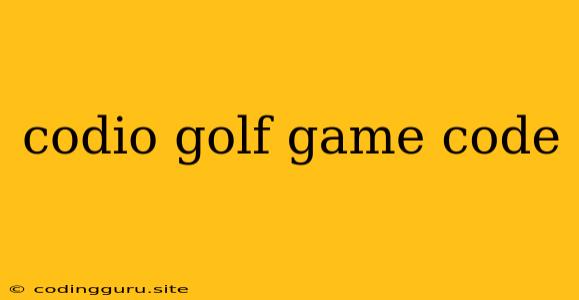Let's Code a Golf Game in Codio!
Are you ready to tee off into the world of game development? Codio is a fantastic online platform that provides a great environment for learning and building projects. Today, we'll embark on a fun journey to create your own golf game using Codio.
Getting Started: Choose Your Weapon
- JavaScript: A popular choice for web development, it's versatile and easy to learn.
- HTML & CSS: The backbone of your game's visual appearance.
- Canvas API: A powerful tool to draw graphics and animations.
The Core Mechanics of a Golf Game
-
The Course: Think of your golf course as a 2D landscape. You'll need to represent this using elements like rectangles, circles, and lines.
-
The Ball: Your ball will be a simple object with properties like position (x, y coordinates) and velocity.
-
Swing Mechanics: The player controls the ball's direction and power, typically with mouse clicks or keyboard input.
-
Collision Detection: How does your ball interact with the environment? Does it bounce off trees or land in a water hazard?
-
Scoring: Keep track of the player's shots and the overall score.
Codio: Your Playground
-
Create a Project: Start a new Codio project and choose a relevant language like JavaScript or Python.
-
HTML Structure: Set up your HTML file as the foundation of your game. Include elements for the game board (like a
<canvas>element), buttons, and a display for the score. -
CSS Styling: Style your game using CSS to create a visually appealing golf course and enhance the gameplay experience.
-
JavaScript Magic: This is where the action happens. Use JavaScript to create your golf ball object, handle player input, manage collisions, and update the game's state.
-
The Canvas API: The Canvas API in JavaScript is a powerful tool for drawing and animating graphics. You'll use it to draw your golf course, the ball, and other elements.
Coding Tips: Hit the Green!
- Break it Down: Divide your game into smaller, manageable tasks (like creating the ball, handling movement, drawing the course).
- Visualize: Sketch out your golf course on paper or using a drawing tool to get a clear idea of its layout.
- Use Loops: Loops are essential for repeating actions like updating the ball's position or checking for collisions.
- Debug Effectively: Use Codio's debugging tools to identify and fix errors in your code.
Simple Code Example: The Golf Ball
// JavaScript code to create a golf ball object
class GolfBall {
constructor(x, y, radius, color) {
this.x = x;
this.y = y;
this.radius = radius;
this.color = color;
}
draw(ctx) {
ctx.beginPath();
ctx.arc(this.x, this.y, this.radius, 0, 2 * Math.PI);
ctx.fillStyle = this.color;
ctx.fill();
}
}
Building Beyond the Basics
Once you have a basic golf game, you can add exciting features:
- Obstacles: Create trees, bunkers, and water hazards to challenge players.
- Power-ups: Introduce elements like a super shot or a wind gust that can affect the ball's trajectory.
- Different Courses: Design multiple courses with varied layouts and levels of difficulty.
- Sound Effects: Enhance the experience with audio cues for swings, ball hits, and scoring.
Conclusion: Fore!
Codio is a powerful tool for bringing your game ideas to life. By applying the concepts we've explored, you can create a fun and engaging golf game that showcases your coding skills. Remember, the journey is just as important as the final result. So, grab your favorite programming language and start building!
